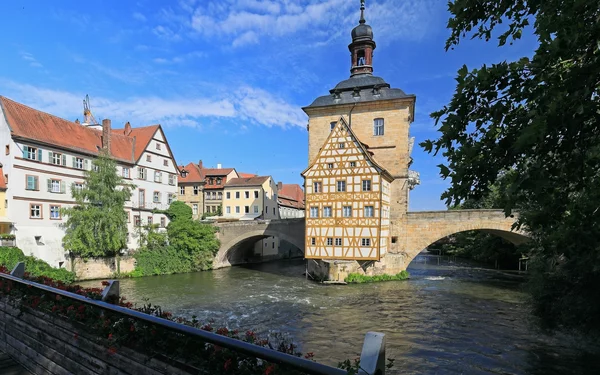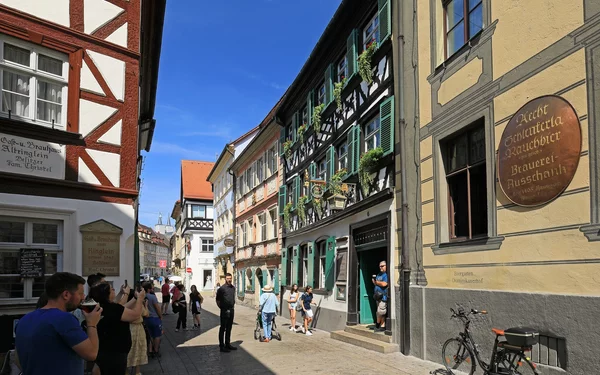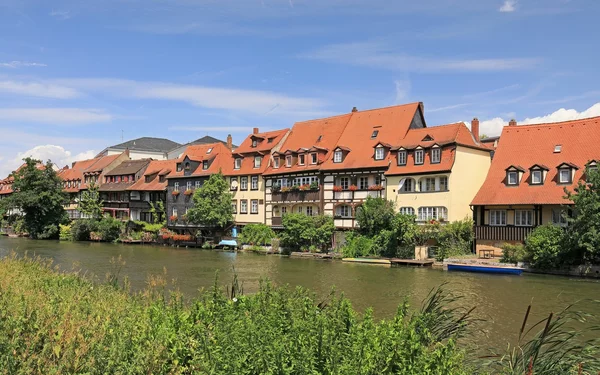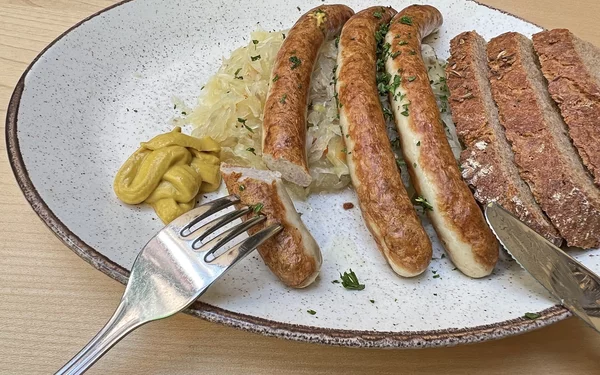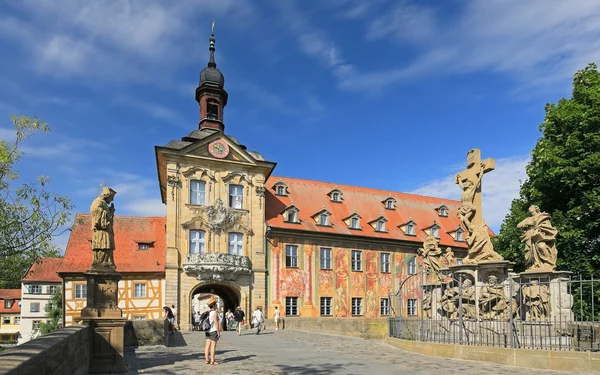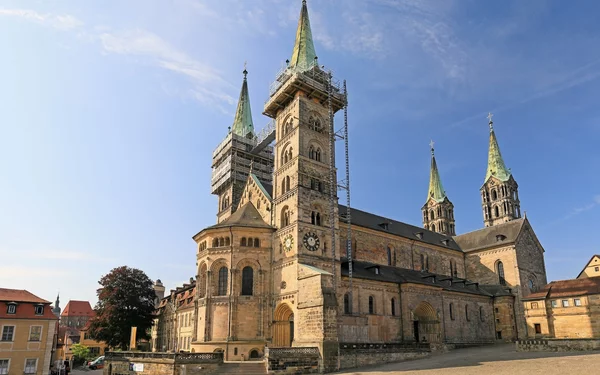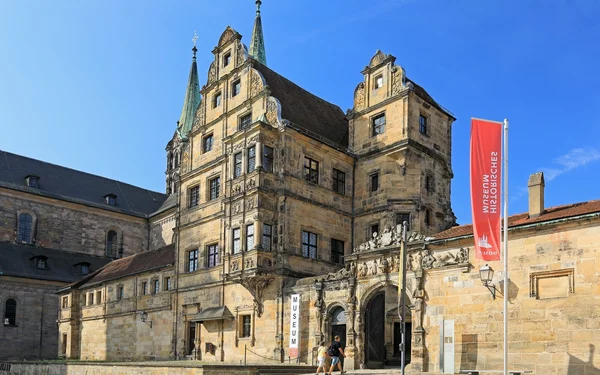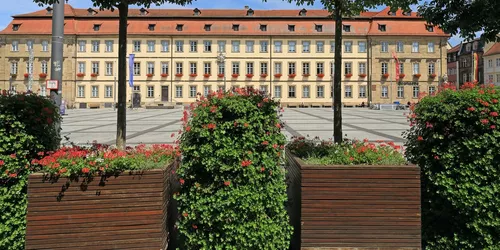Blue tips in "Franconian Rome"
A city tour through Bamberg: admire the majestic cathedral and be enchanted by the idyllic waterways and old half-timbered houses that make Bamberg so distinctive.
Bamberg
4 h
4 km
Those who come to Bamberg can choose: Do you want to enjoy the culinary delights - especially the beer? Or the baroque splendour of the historic old town? Or the Bamberg Horseman and other works of art from church history or the lively, trendy neighbourhoods of a university town? This city tour doesn't ask you to choose - it introduces you to all facets of this exciting Upper Franconian city.
Bamberg lies at the confluence of the Regnitz and Main rivers. The city stretches over seven hills. This similarity to the Italian capital gives it the nickname "Franconian Rome". Bamberg Cathedral and the associated "Old Court" also suggest themselves as a parallel to St Peter's Basilica and the Vatican. It is thanks to its largely intact historic town centre that the entire old town has been recognised as a UNESCO World Heritage Site since 1993.
Fortunately, the railway station and the many sights are not far from each other in Bamberg, so most of them can be easily explored in one day. The route leads through all three areas of the city: the gardeners' town, the island town and the cathedral town. There is no need for any special catering tips here, as Bamberg offers a large number of restaurants, beer pubs and cafés, so you can take a long break almost anywhere and at any time.
How about a charming companion on your way through Bamberg? A former wine queen introduces the city in an audio guide that can be downloaded at www.wir-entdecken-bayern.de/audio-guides. So, off you go.
A city tour for culture lovers and connoisseurs
Start and end station
Bahnhof Bamberg
4 km / 4 Stunden
Bahnhof Bamberg
Our tip: Please make sure to check your train connection and the expected capacity before you start your journey.
Schedule
Tour starts on Bahnhof Bamberg
Direction
Bamberg has a very old railway tradition. Only nine years after the legendary first journey from Nuremberg to Führt in 1835, Bamberg was connected to Nuremberg by rail. Today, the station is the busiest railway junction in Upper Franconia. The approximately 120-year-old station building is on the list of Bavarian architectural monuments.
Once you leave the station, you are in the garden centre, where you can take a closer look around at the end of the tour. First you walk along Luitpoldstraße and then - turning right - along Obere Königstraße. Here you can already see the splendour of the local town houses. You feel transported to a fairytale world. The chain bridge, decorated with thousands of "love locks", cannot be overlooked. The pedestrian bridge leads over a branch of the Regnitz, a section of the Main-Danube Canal, to the island city and directly into the pedestrian zone around Maximiliansplatz. The Bamberg locals simply call it Maxplatz.
Maximiliansplatz and New Bamberg Town Hall
Maximiliansplatz, or Maxplatz for short, is the largest and most important square in Bamberg city centre. It is dominated by the baroque-style New Town Hall, built in the 1730s. Its creator is Balthasar Neumann, who became famous above all for the Würzburg Residence. The square is a centre of attraction for cultural events and the fruit and vegetable market held on weekdays. On Saturdays, the farmers' market is held here, offering mainly Franconian specialities. These include Bamberger Hörnla, not a baked good, but a small and pointed potato, waxy with a nutty flavour. This very high-quality potato variety is mainly sold in delicatessens outside Bamberg. Savoy cabbage is also typical of Bamberg. There are also regular flea markets on the Maxplatz between May and September.
Maximiliansplatz 3
96047
Bamberg
Direction
The Maxplatz is surrounded by baroque buildings with historic houses that are well worth seeing. Be sure to try the typical Bamberg bratwurst. Locals point out that it is exactly the right balance between the fine (Catholic) and the coarse (Protestant) variety. The sausage is also served here as a Franconian national dish: the "Blaue Zipfel". Eating it is an epicurean adventure, as the sausages are not fried but prepared in a vinegar broth and take on a bluish colour in the process.
The following street, Grüner Markt, lives up to its name, as the market stalls are lined up here too. After passing the Neptune Fountain, known as "Gabelmannus", you reach the fruit market, where several restaurants invite you to take a break. Follow the street Am Kranen to the passenger boat landing stage. Where Bamberg's harbour was located until the 20th century, passenger ships depart every hour between 11 am and 4 pm during the season for an 80-minute tour of the old town. The surrounding streets have established themselves as a lively, trendy neighbourhood. This includes the former fishing settlement known as "Little Venice". Densely packed half-timbered buildings and tiny gardens define the image of this neighbourhood. Right next door is Bamberg's most photographed building: the Old Town Hall. Two bridges - the Upper and Lower Bridges - connect it to the island town and the cathedral city via the left arm of the Regnitz.
The Old Town Hall Bamberg
Why does Bamberg's Old Town Hall stand on an island? Legend has it that the island was created especially for the town hall. This astonishing explanation needs explaining: the Bishop of Bamberg, who resided at the top of the hill, did not want to give up any of his land to the citizens for the construction of a town hall. As a result, the citizens drove piles into the Regnitz, creating an artificial island on which they built their town hall. The Regnitz marks the old boundary between the episcopal hill and the bourgeois island town. In its present form, the building dates back to the 1460s. The picturesque half-timbered building on the south side, the Rottmeisterhäuschen, has even been preserved from a previous building. Around 300 years later, it was decorated with the striking façade paintings, which were renewed another 200 years later. The baroque town hall tower is the work of the famous master builder Balthasar Neumann. The long building of the Old Town Hall houses a rococo hall on the first floor, which is used for receptions organised by the city of Bamberg. The ground floor houses the porcelain collection of the collector couple Irene and Peter Ludwig as a permanent exhibition. It is the largest private porcelain collection in Europe.
Obere Brücke 1
96047
Bamberg
Direction
Now it's time to head up to the cathedral city. Passing a plaque in memory of the Hitler assassin Count Schenck zu Stauffenberg, who spent many years in Bamberg, the route leads through idyllic old town alleyways. The shortest route to Bamberg Cathedral is through Karolinenstraße. If you have not yet managed to visit one of the quaint, traditional beer and speciality restaurants, you have plenty of opportunity here. There's the "Hofbräu", the "Ahörnla" or the "Schlenkerla".
Once on the Domberg, the church with its four towers impresses with its size and grace in equal measure. They lend it a majestic aura.
Bamberg Cathedral
Construction of Bamberg Cathedral began in 1004, when the Romanesque style still dominated church architecture, and was completed 40 years later when the Gothic style arrived. The cathedral was given an ornate interior, for which many artists and sculptors from numerous countries came to Bamberg. Among them was the famous sculptor Tilmann Riemenschneider. The building was initiated by the future Emperor Henry II, who is buried in the cathedral next to his wife. The episcopal cathedral is therefore considered an imperial cathedral. The only papal tomb north of the Alps is also located here. The most famous work of art in the cathedral is the Bamberg Horseman, a stone equestrian statue in the Romanesque style from the first half of the 13th century. It is one of the most famous landmarks of the city of Bamberg. The horseman is King Stephen of Hungary. At the time, he had come to Bamberg to marry Emperor Henry's sister.
Domplatz 2e
96049
Bamberg
Direction
Cathedral Square would not be considered one of the most beautiful squares in Germany if it were not for the other historic buildings. Firstly, there is the Old Court, built in the Renaissance style. This is where the prince-bishops lived as spiritual and secular rulers in the 15th and 16th centuries. The entrance portal known as the "Beautiful Gate" is particularly striking. The baroque wings of the New Residence are located directly opposite. It later replaced the Old Court as the residence of the prince-bishops.
Alte Hofhaltung - Bamberg Historical Museum
The Alte Hofhaltung with its Renaissance gable, the "Beautiful Gate" and the picturesque inner courtyard is one of Bamberg's most impressive buildings. Once the residence of the bishops, the building now houses the Historical Museum with precious collections from the World Heritage city. In the "100 Masterpieces" section, the museum displays important paintings from Lucas Cranach to Pieter Breughel and Otto Modersohn. Another exhibition focuses on the River Regnitz, Bamberg's lifeline. During the Christmas season, nativity scenes are exhibited, which have a long tradition in the Bamberg region.
From 1604, the prince-bishops moved into the New Residence opposite. Over 40 richly decorated state rooms give an impression of the extravagant lifestyle of the rulers of the time. Today, the building houses the State Library and the Bamberg State Gallery with masterpieces of old German and European Baroque painting. The rose garden of the New Residence offers a view of St Michael's Church and the roofs of the town.
Domplatz 7
96049
Bamberg
Direction
After the panoramic view of the cathedral square, the route now leads back to the railway station. It leads around two kilometres through Bamberg's fascinating old town and introduces you to the garden city. It goes through Residenzstraße, through the Iron Gate, along Untere Sandstraße and through Markusstraße to Markusbrücke. From here, Bamberg once again shows its most idyllic side along the Regnitz. You walk through the island town and reach the Löwenbrücke, which impresses with its four pylons that glow in the dark. Through Färbergasse and a few metres to the right into Mittelstraße, you reach the garden city and the Gardeners' and Growers' Museum. Fruit and vegetables have always been grown in and around Bamberg. This includes viticulture, which is called "Häckerei" here. This part of Bamberg has retained its village character thanks to the typical residential barn houses with a central driveway and courtyard and garden at the back.
The gardener and horticulturist museum
A gardener from the 18th century would immediately find his way around the house and garden and be able to go about his daily work straight away. The current museum building was erected in 1767 as a drive-through and stable house in a functional design for gardeners' houses of the time. The house belonged to the Kauer family, who lived in it until the 20th century and made a considerable fortune thanks to good business. The last descendant of the Kauer family lived here until 1969.
A gardener's house with a draw well had already stood here around 1600. The furnishings of the museum were modelled in every detail on the beginnings and development of gardening culture in Bamberg. The black kitchen is identical to those used by the gardener families who lived here around 1769. The parlour is furnished in the style of the 19th century. The farmyard, including the coach house with all its utensils, gives a clear impression of the way gardening families lived and worked in the 18th and 19th centuries. In the kitchen garden next to the house, everything that the kitchen demanded at the time and that was part of the Bamberg specialities is planted. A separate part of the house and garden is dedicated to the life and work of the Häcker family. They originally worked as winegrowers on the hillsides around Bamberg, but had to switch to cold-tolerant crops during the Little Ice Age, including hops.
Visitors can discover the museum and garden on their own with an audio guide or book a guided tour.
Mittelstraße 34
96052
Bamberg
Tour ends on Bahnhof Bamberg
Direction
After visiting the museum, continue along Mittelstraße and turn into Luitpoldstraße. If you fancy a vegan end to your excursion in the garden centre, then the Vegan Food Rebels Bamberg is a good recommendation. It is open Wednesdays to Saturdays from 12 to 2 pm and 5.30 to 8 pm. Luitpoldstraße leads directly to the railway station.
